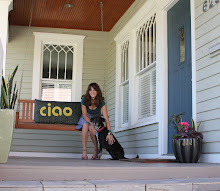 When I first saw the eclectic, cool, faux bois paneling in the bathroom of Shauna Alterio & Stephen Loidolt of something's hiding in here, I was totally smitten. The apartment was featured as a design*sponge sneak peek here, and also been featured on Etsy's There's No Place Like Here series.
When I first saw the eclectic, cool, faux bois paneling in the bathroom of Shauna Alterio & Stephen Loidolt of something's hiding in here, I was totally smitten. The apartment was featured as a design*sponge sneak peek here, and also been featured on Etsy's There's No Place Like Here series. Shauna and Stephen shared their instructions for making your own faux bois paneling via Readymade magazine online, (which is where my faux bois paneling project began,) however sadly, I can no longer find the instructions anywhere on Readymade's website. Shauna gave these simple instructions on design*sponge:
"we painted it using a very simple plastic “wood graining” tool from home depot. all you need is two colors of paint and this tool it’s so easy."
I found their instructions very helpful, however I wanted to share a few additional tips I learned while making my own paneling. My first faux bois project was to make paneling for my dining room window seat. You can see it below on the walls and ceiling of the window cut-out.



After installing my dining room paneling, I became obsessed, and made some for my guest room in my loft/studio space. (below) Here's what I learned while painting the paneling:
Here's what I learned while painting the paneling:
 Here's what I learned while painting the paneling:
Here's what I learned while painting the paneling:* Home Depot stopped carrying the graining tool in store, but you can still find it at many paint stores, or online here.
* Choose two contrasting colors. I chose navy/light grey for the dining room, and turquoise/light grey for the guest room. I opted for the darker of the two for the base, and the light grey to create the grain effect. Opt for latex paint.
* I purchased the unfinished paneling at Lowe's. First, paint the paneling in a solid base coat of chosen color. Then mix a 3 to 1 ratio of paint to water with the graining color to make a glaze like paint mixture. Making a glaze seemed to make the graining tool slide easier down the paneling, and extended the drying time of the top coat, allowing more time for working.
* Paint one panel piece at a time, and then immediately use the graining tool by sliding it down the board, rocking your tool back and forth as you drag. This creates the grain effect. Wipe excess paint off of the graining tool between boards.
* Alternate the direction that you drag the tool down the board...top to bottom, then bottom to top for the next board. This will help insure that your pattern does not look too similar for each board. Hang and admire!














































